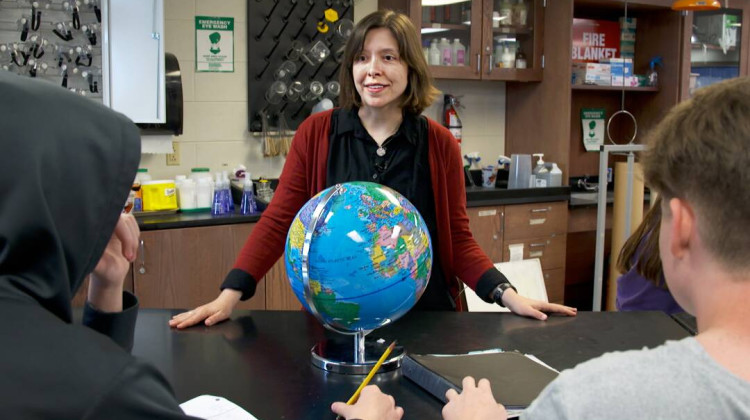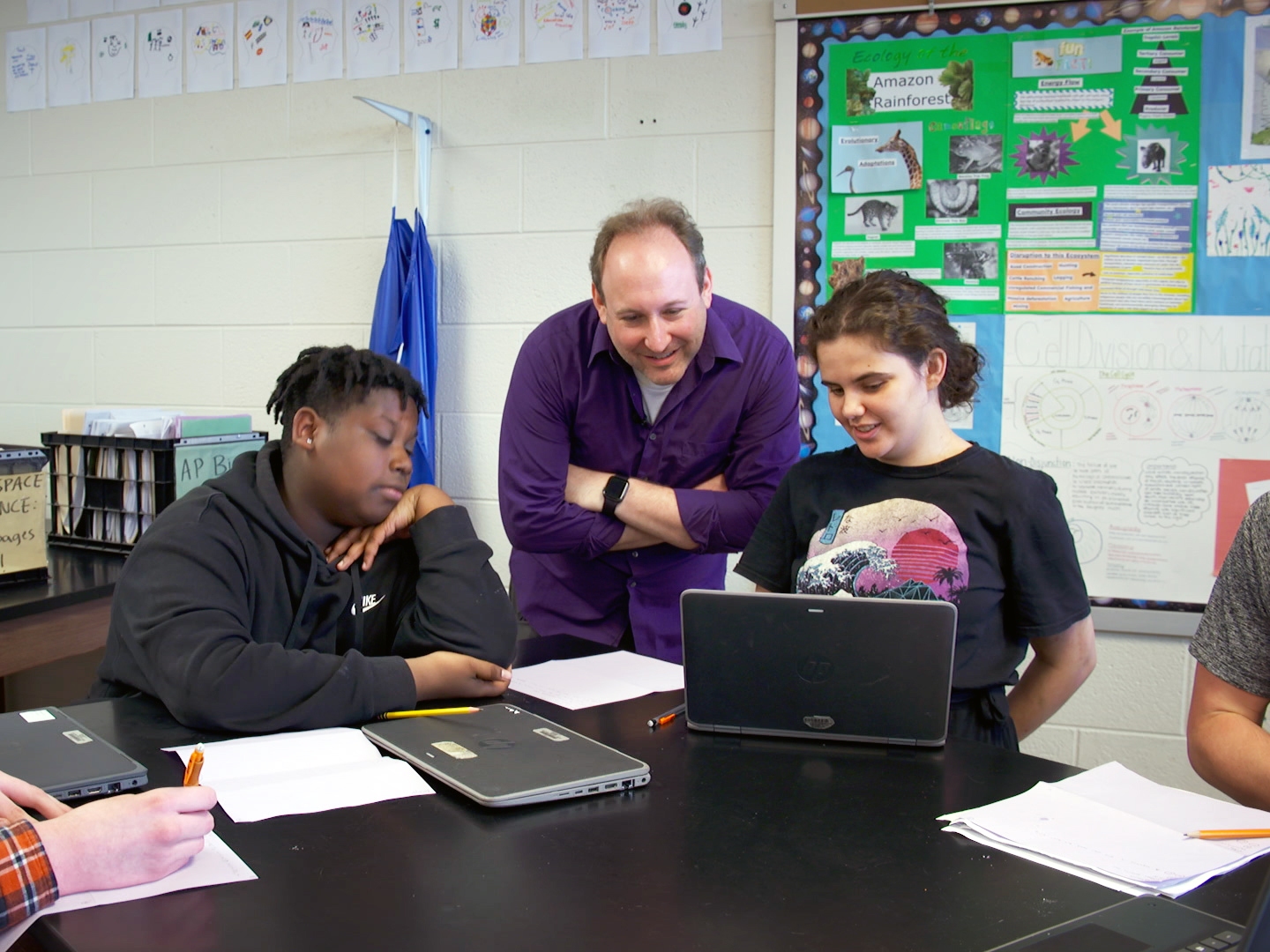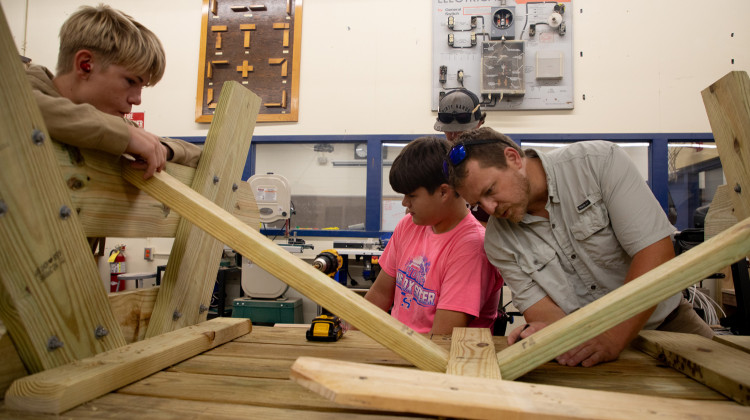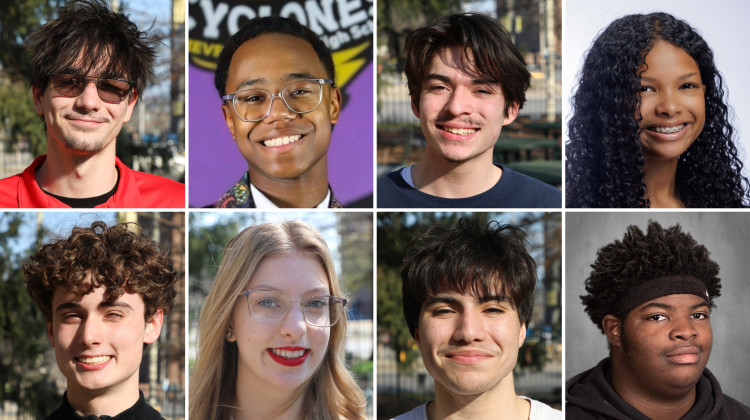
Bloomington High School South science teacher Kirstin Milks leads a lesson on human-caused climate change and technologies that could help reduce greenhouse gas emissions.
Chris Elberfeld / WFYIHigh school freshman DeWayne Murphy has a big idea for a new green technology.
“There's going to be a tank and it should be like a big giant metal tank,” he explains to climate scientist Ben Kravitz on a school day in May. “You fill it up with water, and the tank is going to heat up.”
The water will turn to steam, which will power a car. But it has some potential drawbacks.
“It's not really designed to take any damage, like at all, so you have to be like really gentle with it,” Murphy says.
“What I really like about that is steam’s kind of an old tech,” Kravitz tells him. “Steam works. We know that. So, yeah, that's a really cool idea.”
This conversation is part of a larger lesson about developing technologies that reduce planet-heating pollution. The lesson was created by Kravitz, an assistant professor of earth and atmospheric sciences at Indiana University; his colleague Paul Goddard; and Kirstin Milks, DeWayne Murphy’s science teacher at Bloomington High School South in Bloomington, Ind.
Indiana recently approved new standards that now require high school students in earth and space science to learn about human-caused climate change.
With heat waves and extreme weather becoming more and more common, Milks wants to empower her students with information and the creative freedom to dream up big ideas for a better climate future.
“The fact is that climate change is the story of these young people's lives,” Milks says. “Our students need to know not just the stuff about it that is challenging and difficult, the stuff we hear about in the news, but also they need to see how change can happen. They need to feel like they understand and can actually make a difference in our shared future.”
Milks teaches her students the basic facts about human-caused climate change: that burning fossil fuels — like coal, oil and gas — is the biggest single driver of increased carbon dioxide in the atmosphere. Carbon dioxide heats the planet, which has led to more frequent droughts, hurricanes, floods and intense heat waves.
Kravitz says, “The only permanent solution to stopping that is reducing our greenhouse gas emissions.”
Scientists already know some technologies that could help. Solar and wind energy combined with big batteries are helping the world transition away from oil, coal and gas.
But Kravitz says the world isn’t moving fast enough. So he and other scientists are studying strategies to temporarily alter the Earth’s climate to reduce the effects of climate change. It’s known as climate engineering, or geoengineering.
Climate engineering covers a range of strategies, including reflecting sunlight back into space and removing carbon dioxide from the atmosphere. But these strategies can also pose significant risks — like disruptions to rain patterns and impacts on global crops. Meanwhile, there’s still little regulation over how these technologies might get used.
“The people who are going to be voting on whether to [pursue climate engineering], or even leading the charge, are sitting in high school classrooms right now,” Kravitz says. “So if they don’t know what this topic is, that’s a real problem. So that’s why we developed the lesson.”
Milks says she isn’t trying to persuade students to embrace climate engineering — rather, she wants to give them the knowledge they need to make informed decisions about it, if and when the time comes.

Students think up wild ideas, like covering the desert in glitter
Creativity is at the core of this lesson, Milks explains. After students learn the basics of climate engineering, they’re asked to “come up with interesting wild ideas” to slow global warming.
At first, no idea is too out there, says Goddard, an assistant research scientist at Indiana University who helped develop the lesson.
“As we progress along throughout the lessons, then we add more details, more constraints to their designs,” Goddard says.
In the first round of brainstorming, students imagined a solar-powered helicopter; artificial trees that store rainwater to help fight wildfires; and lots of ways to reflect light back into the atmosphere, like covering the desert in shiny glitter.
Next, students are asked to consider the potential limitations and risks to their ideas. Take glitter in the desert, for example:
“How are we going to make sure that the glitter doesn't get eaten by the rock pocket mouse … or like snakes and stuff?” Milks asks.
The student suggests making the glitter large and smooth enough so it won’t be eaten by animals or otherwise harm them.
For their final assignment, students present their concepts — including their anticipated benefits and risks — to Kravitz, Goddard and other scientists.
High school junior Campbell Brown has an idea for a flying air filter that sucks carbon dioxide out of the atmosphere and turns it into a harmless byproduct.
“It'll decrease the amount of greenhouse gases that are in the air,” she explains during her presentation. “The risks could be that it just doesn't work the way I want it to.”
Kravitz is impressed.
“So you want to know something? It does work,” he tells Brown. “The waste product that you get out of it is baking soda, essentially. So yeah, it works, it just can't be widely deployed right now because it's too expensive.”

Fostering climate optimism
Brown is thrilled that her idea is something scientists are currently studying, especially because she didn’t know much about climate change before this lesson.
She was saddened to learn how humans have contributed to climate change and its effects on the planet, but she says she’s leaving this lesson with a newfound sense of hope.
“Because rather than the old generation leaving something broken for us to fix, we're also getting help from that generation. And so that way, we're all helping each other out and fixing what we have caused,” she says.
Emerald Yee, a senior in Milks’ class, has been concerned about climate change for a while. She has a family member with a chronic health condition that’s exacerbated by heat.
“So for me, I’m mainly just worried about [their] safety when it comes to climate change and global warming,” Yee says. She says this lesson gave her the tools to “really think about climate change and how we can change it and make it better for not just our generation, but the younger generations, our younger siblings, or even our kids and grandkids.”
For Kravitz, fostering climate optimism is a big part of this lesson. And he says hearing students’ ideas for solutions always makes him feel better.
“The neat thing about seeing all of these ideas come out of the classroom is it's not I can't do it. It's we can do it. Humans, when they get together, can do amazing things. And that's what gives me hope.”
Contact WFYI investigative education reporter Lee V. Gaines at lgaines@wfyi.org.
 DONATE
DONATE






 Support WFYI. We can't do it without you.
Support WFYI. We can't do it without you.